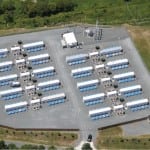The energy storage market received a boost Oct. 17 when the Federal Energy Regulatory Commission (FERC) approved the first two compliance filings implementing Order 841, a rule the commission said is designed to eliminate market barriers to electricity storage.
Order 841 was enacted in February 2018. The measure directs regional power grid operators to establish rules opening capacity, energy, and ancillary services markets to energy storage, and affirms that storage resources must be compensated for provided services. (Read “5 Key Takeaways from FERC’s Recent Energy Storage Order” in the June 2018 issue of POWER.)
“Electricity storage must be able to participate on an even playing field in the wholesale power markets that we regulate,” said Neil Chatterjee, FERC chairman, on Thursday. “Breaking down these market barriers encourages the innovation and technological advancements that are essential to the future of our grid.”
Regional grid operators submitted the first compliance plans in December 2018. FERC’s orders Thursday concern the compliance filings of Southwest Power Pool (SPP), a regional transmission organization (RTO) that serves all or parts of 14 states, and PJM Interconnection, the RTO serving all or parts of 13 states and the District of Columbia. FERC found the two market operators mostly complied with Order 841, and said it largely accepted their filings, though the agency did provide additional directives for further action.
FERC on Thursday said it found that proposals from both PJM and SPP would for the most part enable electric storage resources to provide all services within their capability, and would allow those storage resources to be compensated for services in the same way as other resources. The commission also said the RTO’s filings recognize the unique physical and operational characteristics of electric storage resources. FERC directed both SPP and PJM to submit further compliance filings to address other issues within 60 days.
Joe Hall, a partner with global law firm Eversheds Sutherland, told POWER in an email Thursday: “The potential for cost-effective energy storage development and integration presents a once-in-a-generation opportunity. In my mind, there are four basic storage models, each implicating different federal and state regulatory issues. While it certainly includes battery technologies, the first model is in the tradition of large-scale pumped storage projects meant to satisfy significant native load obligations. The second model is smaller scale storage (often paired with renewable generation). These projects certainly can be used to satisfy native load obligations, but often are discussed in the context of merchant dispatch into organized ancillary services markets. The third model is storage as an alternative to a transmission upgrade. The fourth model is storage as an alternative to a distribution upgrade.
“The first and fourth models certainly raise complex issues, but the relevant projects tend to be developed as a result of state-integrated resource programs focused on the encouragement of renewable generation and therefore do not usually require FERC to make policy-level determinations concerning potential barriers to entry, ratemaking and/or pricing. The second and third models, however, raise much more difficult issues for FERC because these types of projects implicate policy issues squarely within FERC’s jurisdiction. With respect to storage, I think this FERC is signaling that it prefers not to ‘tinker’ with markets and is trying to walk the difficult line of eliminating barriers to entry while ensuring comparability between generation/transmission alternatives, and not risking markets potentially overcompensating storage based on its current physical characteristics.”
FERC on Thursday also initiated proceedings under Section 206 of the Federal Power Act to address the specific issue of minimum run-time requirements. PJM in September of last year addressed minimum run time in a document answering questions about electric storage resources. FERC in Thursday’s action said tariffs for both market operators generally satisfy 841’s directive allowing electric storage resources to de-rate their capacity to meet minimum run-time requirements, but the commission said that neither market includes in its tariff minimum run-time requirements for resource adequacy and capacity.
The commission said those run-time requirements affect rates, terms and conditions of service, which is why it is beginning Section 206 proceedings. FERC directed SPP and PJM to submit tariff provisions that detail their rules and practices regarding resource adequacy minimum run-time requirements, and capacity minimum run-time requirements, for all resource types. The RTOs must submit these tariff provisions within 45 days after the 206 notice is published in the Federal Register. FERC also established paper hearing procedures to examine PJM’s minimum run-time rules and procedures as applied to capacity storage resources.
“Storage technologies are developing rapidly so the scope of potential barriers to entry and appropriate pricing will remain hotly debated issues as storage technologies evolve,” Hall told POWER. “Discussions concerning storage are ongoing around the country [especially at the RTOs], so I think FERC’s orders on the Order 841 compliance filings are only the beginning of a much longer process at FERC. Stay tuned.”
—Darrell Proctor is a POWER associate editor (@DarrellProctor1, @POWERmagazine).










